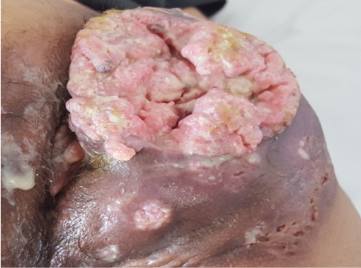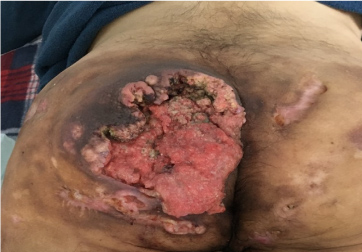Hidradenitis Suppurativa (HS), also called Acne inversa, is a Chronic inflammatory, suppurative, fistulizing disease, with a risk of malignant degeneration to squamous cell carcinoma (SCC). We report an intriguing case of a patient who developed an aggressive form of HS within a very short time of nine years, indeed, the patient was infected with the human immunodeficiency virus (HIV) and human papilloma virus (HPV). We believe that the oncogenic role of HPV was increased, given the very fast degeneration and propose a surgical cure at an earlier stage, particularly when a very close follow-up cannot be insured.
Hidradenitis suppurativa, Squamous cell carcinoma, Immunodeficiency
Hidradenitis Suppurativa (HS) is a chronic, inflammatory, recurrent, debilitating, skin follicular disease that usually presents after puberty with painful deep seated, inflamed lesions in the apocrine gland-bearing areas of the body [1]. It is an inflammatory disorder of the follicular epithelium, but secondary bacterial infection can often occur. The diagnosis is made clinically based on typical lesions (nodules, abscesses, sinus tracts), locations (skin folds), and nature of relapses and chronicity [2]. Cutaneous Squamous Cell Carcinoma (cSCC) tumors that arise from chronic inflammatory processes, called de novo cSCC, are more aggressive and unpredictable than conventional cSCC [3]. We report and discuss a very intriguing case of a cSCC complicating HS in an HIV positive patient.
We report a case of 40-year-old HIV positive man, co infected with HPV, CD4/ cell count was 82/mm3 and viral load was 98056 copies per milliliter (copies/mL). He has 9 years history of Perineo-gluteal hidradenitis suppurativa, unimproved despite long-term treatment with topical and systemic antibiotics (Cyclins, Clindamycin, rifampicin) and oral isotretinoin. Physical examination revealed the clini¬cal picture of hidradenitis suppurativa Hurley stage II, with abscesses, draining fistulas, sinus tract formation and scars, centered by an exophytic and ulcerated tumor measuring 10 cm on the major axis, on his left buttock (Figure 1), biopsy of which showed well-differentiated SCC. The extension assessment reveals local aggressiveness with deep musculo-aponeurotic infiltration and osteolysis of the sacrum and coccyx, no distant metastases was detected. Large cutaneous excision was performed in combination with palliative chemotherapy. The patient died shortly after due to a pulmonary embolism (Figure 2).
 Figure 1: Vegetative tumor measuring 10 cm on the major axis of the left buttock in an HIV+ patient. View Figure 1
Figure 1: Vegetative tumor measuring 10 cm on the major axis of the left buttock in an HIV+ patient. View Figure 1
 Figure 2: The patient is followed for Hidradenitis Suppurativa with sinus tract, scars and fistulas of the two buttocks. View Figure 2
Figure 2: The patient is followed for Hidradenitis Suppurativa with sinus tract, scars and fistulas of the two buttocks. View Figure 2
SCC is a late and uncommon complication of HS, the reported prevalence of malignant transformation in HS varies between 1.7% [4] and 4.6% [5]. Anogenital localization is the most common [6], mostly in men 86% [7]. The average age of the reported cases was 52 years [8].
De novo cSCC is a particularly aggressive variant of SCC, with frequent metastatic spread and high mortality rates [9]. Lavogiez, et al. [5], found that nearly half of 38 patients with SCC in HS, had lymph node metastases on follow-up, versus 5-10% in SCC of any aetiology, and that 57% of 52 patients died within 2 years, with only 19% alive and free of recurrence after 1 year.
The peculiarity of this clinical case is the very fast aggressiveness and especially, the malignant degeneration after only nine years of evolution, contrary to the data in the literature which reports an average of 25 years duration of HS prior to SCC diagnosis [8].
In 2018, Omland, et al. [10], estimated the risk of non-AIDS defining skin cancer, basal cell carcinoma (BCC), SCC and Melanoma in HIV-infected patients, they found that patients with HIV had an increased risk of BCC and SCC. Low nadir CD4 cell count was associated with an increased risk of SCC. On the other hand, HPV has been detected in a proportion of cutaneous SCC, and a possible etiological role has been suggested, especially in the immunosuppressed individuals. However, no mechanism of carcinogenesis has yet been found.
Indeed, HIV infection is associated with high-risk cSCC [3], especially in the case of perianal localization. An explanation may be that SCC in HS mostly occurs in the perineal/perianal/gluteal areas, with higher prevalence of HS in these areas among men, and the potential role of bacteria/viruses as a regional cofactor in combination with chronic inflammation in the development of SCC [5]. The presence of certain HPV types is a known risk factor for the development of anogenital SCC [11], and a similar association has been hypothesised for the cutaneous SCCs associated with HS.
In our patient, HPV seems to have played a crucial oncogenic role, explaining the extremely fast and aggressive progression of HS to cSCC, this degeneration is favored by the therapeutic challenge ans dilemma of HS in HIV patients, in whom, immunodeficiency may affect the clinical course of this skin condition and its therapeutic response.
In HIV-positive patients suffering from HS, we should discuss earlier, the surgical indication of wide excision, because of the high risk of malignant degeneration and de¬velopment of aggressive squamous cell carcinomas with very poor prognosis.